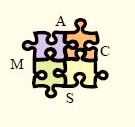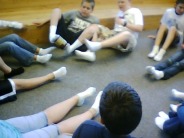Movement, Anxiety, Communication, and Sensory differences in Autism Spectrum Differences (ASDs)
One of the greatest challenges today is an information divide between biophsyiological research and the research done in social science fields
including education. What biophysiological research has been discovering about autistic brains is rocking the core assumptions many in the social sciences have had about autism for years. A lot of that information has yet to trickle down to even pediatricians and medically-oriented service providers who continue to rely on behavioral criteria to diagnose ASDs. Not that I'm recommending neuroimaging for everyone suspected of having autism! But what we are learning from biophysiological research can help short-cut hypotheses about what
may be challenging a specific individual and what evidence-based practices drawn from the social sciences including educational research is more like to be helpful to that individual. Applying those ideas about Movement, Anxiety, Communication, and Sensory systems as well as the interconnectivity between those systems and other systems of the brain during an ecological assessment*, and mapping best practices/evidence-based practices onto the result of such an assessment, is what I mean by "the MACS approach."
including education. What biophysiological research has been discovering about autistic brains is rocking the core assumptions many in the social sciences have had about autism for years. A lot of that information has yet to trickle down to even pediatricians and medically-oriented service providers who continue to rely on behavioral criteria to diagnose ASDs. Not that I'm recommending neuroimaging for everyone suspected of having autism! But what we are learning from biophysiological research can help short-cut hypotheses about what
may be challenging a specific individual and what evidence-based practices drawn from the social sciences including educational research is more like to be helpful to that individual. Applying those ideas about Movement, Anxiety, Communication, and Sensory systems as well as the interconnectivity between those systems and other systems of the brain during an ecological assessment*, and mapping best practices/evidence-based practices onto the result of such an assessment, is what I mean by "the MACS approach."
Here is an icon used by the Autism Spectrum Differences Institute of New England, Inc., the 501(c)(3) organization I founded, to illustrate the MACS approach.

I get a LOT of flak from my "aspie"/"autie" friends about the use of the puzzle piece because, as many of them say, "We are NOT a puzzle!" I totally agree but, truly, there still are what I consider to be very good reasons for the use of this particular icon: (1) It represents the interlock-edness (if there is such a word) of M=Movement, A=Anxiety, C=Communication, and S=Sensory neurological components of autism. (2) Thanks to other autism groups, it is almost universally recognized so, when someone stops to ask whether this icon has something to do with autism, I get to regale them with pretty much everything you're reading on this website. Hey. They ASKED first. Ask and ye shall receive. (3) I LOVE what a group of 5th graders once said when asked to come up with a slogan for their classroom (which happened to fully include a student with classic autism). They said: "We are ALL part of a HUMAN puzzle and, without every single one of us, the puzzle is incomplete."
Here is a link to a short paper I wrote and continually update as new information (e.g., about the connectivity between MACS systems of the brain and between those systems and other systems of the brain) becomes available: (WHOOPS! This paper isn't on the website I was linking to yet so you'll have to wait until I make sure someone else gets it up before I can link to it!)
I am also writing "The Book" (as my friends call it) -- and have been for over 10 years -- but there is always something to distract me! The book will detail lots of the information about MACS differences, how to identify them, what their implications are, and what is more likely to work for individuals with ASDs under certain circumstances. I'll also be addressing family needs, inclusive schooling, inclusive life in the community, friendships, and positive behavior supports that are MACS-driven. Until the book is published, though, you'll have to attend one of my workshops or take one of my courses. Dates and registration info are posted on my Upcoming Workshops! page.
By the way, this is cutting edge stuff in one sense but some colleagues and I (notably Paula Fredericks, Ed.D., who is an educational consultant working primarily in Western MA), have been successfully using the MACS approach for years. We also get very positive feedback from former students of courses and workshops we've co-taught with each other (or, in my case, co-taught with Jacob Pratt) who have used the MACS approach in their own classrooms or other contexts. And, it is the only approach we know that has been developed WITH people who have the full range of autistic challenges. As Hope Block typed, "Finally, someone knows what it's like to be me."
MACS is consistent, for example, with many practical uses of applied behavior analysis, DIR/Floortime (TM), How Does Your Engine Run and other sensory integration approaches, best practices in Early Childhood education, best practices in general education, and many complementary and alternative therapies. Yet, it is not, as I said in another page of this website, a "one size fits all" model.
I am also writing "The Book" (as my friends call it) -- and have been for over 10 years -- but there is always something to distract me! The book will detail lots of the information about MACS differences, how to identify them, what their implications are, and what is more likely to work for individuals with ASDs under certain circumstances. I'll also be addressing family needs, inclusive schooling, inclusive life in the community, friendships, and positive behavior supports that are MACS-driven. Until the book is published, though, you'll have to attend one of my workshops or take one of my courses. Dates and registration info are posted on my Upcoming Workshops! page.
By the way, this is cutting edge stuff in one sense but some colleagues and I (notably Paula Fredericks, Ed.D., who is an educational consultant working primarily in Western MA), have been successfully using the MACS approach for years. We also get very positive feedback from former students of courses and workshops we've co-taught with each other (or, in my case, co-taught with Jacob Pratt) who have used the MACS approach in their own classrooms or other contexts. And, it is the only approach we know that has been developed WITH people who have the full range of autistic challenges. As Hope Block typed, "Finally, someone knows what it's like to be me."
MACS is consistent, for example, with many practical uses of applied behavior analysis, DIR/Floortime (TM), How Does Your Engine Run and other sensory integration approaches, best practices in Early Childhood education, best practices in general education, and many complementary and alternative therapies. Yet, it is not, as I said in another page of this website, a "one size fits all" model.
Joey provides a great example of how MACS has been successfully applied at home, in his inclusive education, and in community settings.

Here is a group of 5th graders playing "The Can Game," a noncompetitive game taught to them by their school district's inclusion facilitator, Cheryl Morrill. The object of the game is for the kids to cooperate in passing the can with their stocking feet only (no hands allowed!) and not letting it drop to the floor -- which means they have to help out anyone who has the can but is in danger of losing control of it. If the can drops, the consequence is that they start over! No winners, no losers -- just a group of kids having a great time. The photo was taken during lunch time. The kids are members of Joey's Circle of Friends. Joey does not use his oral language to communicate effectively although, since he's been typing, his speech has improved greatly by any standard. Joey was one of those kids who used to tantrum and bolt. He still can have pretty serious meltdowns when thwarted or when "being a brat" at home. Outside his house, if it weren't for his "TV talk," unusual postures and expressions, and lack of consistent eye contact, you'd never know he had autism. The reason? Joey's had an inclusive education where he's been surrounded by neurotypical kids as role models, held to high expectations tempered by a realistic approach as to how his MACS differences make it difficult for him to "show what he knows," and exposed to the same kinds of experiences as other young men his age enjoy (basketball, hiking, biking, and video games, for example). Can you tell who's Joey?!?!
